Seville, also called Sevilla, is one of many people’s favorite cities in Spain. It’s the home of flamenco dancing, is light on historical sites (although there’s still plenty to keep you busy on a short visit), and is a great place to just slow down and take a break from a fast paced itinerary.
I spent two days in Seville and expected to fall in love with the city. It almost felt like a disappointment when that didn’t happen. Don’t get me wrong, Seville is a great city. But I found that I enjoyed Granada more.
However, it is important to mention that even though I visited in October, it was still very hot and sticky. I absolutely hate weather like that, so that automatically knocked Seville down a few notches in my ranking of the best Spanish cities. Despite its weather, I still believe most travelers should add Seville to their Spain itinerary.
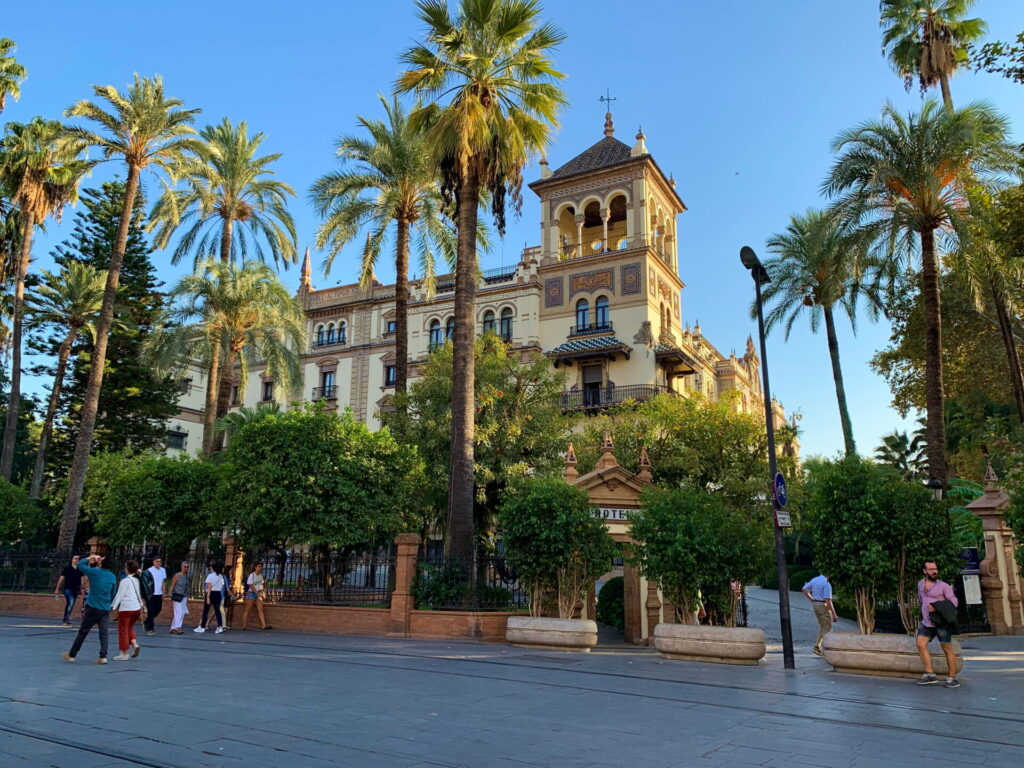
Top Sights in Seville, Spain
I already mentioned that Seville is a city that is light on sights, but that doesn’t mean there aren’t plenty of things to do. Even if you’re using Seville as a break from a much faster itinerary, here’s some of the sites you should still visit.
As a note, all of these can be visited with two days in Seville. I’ll cover an actual itinerary later in this post.
Seville Cathedral (Catedral de Sevilla)
This cathedral is massive and in my opinion its one of two must see sights when you’re in Seville. Whether you have one day or two days in Seville (or even a week), add a visit to the cathedral to your itinerary.
The Seville Cathedral is the size of a Manhattan city block and is the third largest church in Europe. The cathedral sits on the remains of a mosque that was torn down in 1401. In 1528, the cathedral was finished and at that point, it was the largest cathedral in the world.
From the outside you can marvel at its brilliant Gothic architecture, while inside you’ll see it’s incredible gold decor. It seems that everything in this cathedral is magnificent and filled with detail. I guess that’s what happens when you destroy a mosque and build a cathedral over it during the Spanish Reconquista.
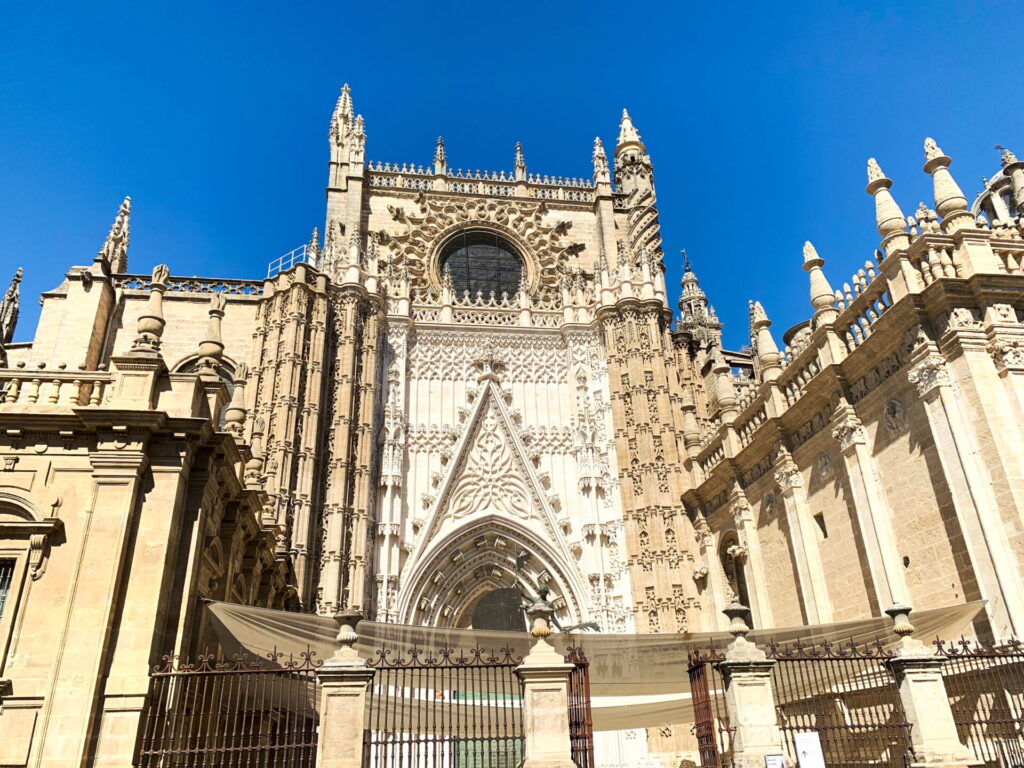
While the cathedral holds a lot of art, it also holds the tomb of Christopher Columbus. When Columbus left on his 1492 journey, he departed not far from here. Knowing that, it’s no surprise why his remains finally ended up here. Before arriving in Seville, his remains were moved around the world, starting in Valladolid, Spain then moving to Seville, then to the Dominican Republic, then to Cuba, and then finally making their way back to Seville.
After you finish marveling at the interior, take the time to climb the Giralda Bell Tower. This is included in your entry fee. So climb the tower (which is actually a former minaret from the original mosque). It’s a climb to the top (330 feet across 35 ramps and 17 steps), but your reward is a grand view over Seville. As you climb to the top, periodically stop at the balconies and windows to get a preview of the views (and to catch your breath!).
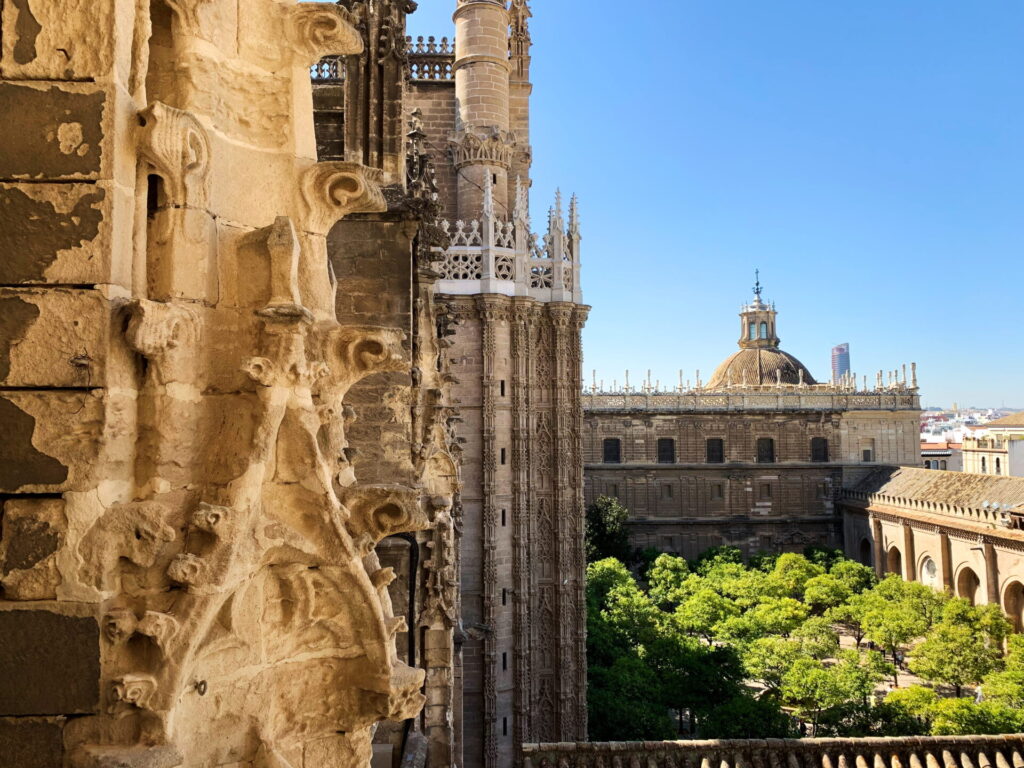
Logistics: Entrance to the Cathedral, including climbing the bell tower, is 13 euro when purchased online. When you purchase your tickets online, you’ll be given a timed entry so you can skip the line. On hot summer days, this is necessary. Give up the flexibility (and save one euro) and purchase your tickets online in advance. NOTE: Your ticket is a combo ticket giving you entrance into the Cathedral, the bell tower, and the Church of the Savior.
Church of the Savior (Iglesia El Salvador)
On my visit to Seville, I didn’t plan to visit the Church of the Savior. However, when you buy a ticket for the Seville Cathedral, you are given a combo ticket that includes both churches.
Church of the Savior is Seville’s second largest church (behind the Seville Cathedral). The Church of the Savior is Baroque, while the Seville Cathedral has a gothic style. So while you will tour two churches, they both have different styles (at least on the outside).
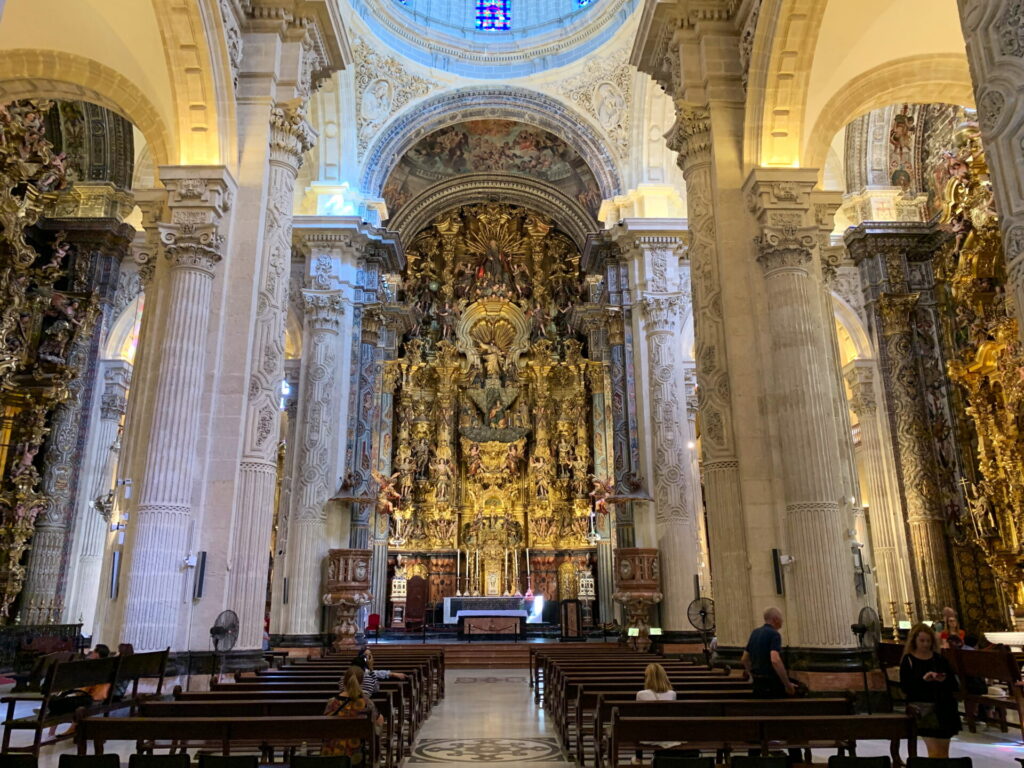
The interior of the church is intricately decorated and filled with gold decorated statues. The chapels are also a huge favorite with visitors. However, for me, the highlight was seeing some of the Semana Santa (or Holy Week) floats. During Holy Week, floats depicting scenes from Passion of Christ are paraded through the streets of Seville. Seeing these floats and statues up close was stunning.
Logistics: Entrance to the church is 13 euro when purchased online. There is no timed entry at this church. NOTE: Your ticket is a combo ticket giving you entrance into the Cathedral, the bell tower, and the Church of the Savior.
While I do recommend purchasing your ticket online in advance to get a timed entry for the Seville Cathedral, it’s ok if you don’t. Instead of going to the Seville Cathedral, come to the Church of the Savior first. On my visit, the line at the Church of the Savior consisted of about three people, compared to the line at the Cathedral which seemed to have fifty to one hundred people in it.
Royal Alcazar
The Royal Alcazar is a Seville’s former palace and is absolutely spectacular. If you’re spending two days in Seville, you have to tour this former palace.
You’ll walk through decorated halls and courtyards before making your way out to the gardens. Being a former palace, this building is full of art and other artifacts, but it also has a lot of history. King Ferdinand and Queen Isabella lived here. Christopher Columbus visited here when he returned from his travels. Ferdinand Magellan planned his travels here as well. And that just scratches the surface of the history of this place. Take your time as you explore to soak in everything.

If you’re here on a hot day, explore. While they didn’t have air conditioning back in the days of Ferdinand and Isabella, there are still some unique natural air conditioning locations that provided some much needed relief from the heat and humidity.
Logistics: Tickets cost 15.50 euro and can be bought at the Alcazar. However it’s a better idea to purchase them online in advance from the official website. I made my reservation the day before. So while I was still able to visit, I was very limited on what time I could visit. For more tour options, book early.
Plaza de España
I almost missed this during my visit to Seville. I was looking at postcards and I kept seeing the Plaza de España, so in the morning on my second day, I went to check it out. This plaza is wonderful and while full of tourists, it’s definitely worth a stop. I’m still not sure how I managed to plan two days in Seville and completely miss adding this to my itinerary.
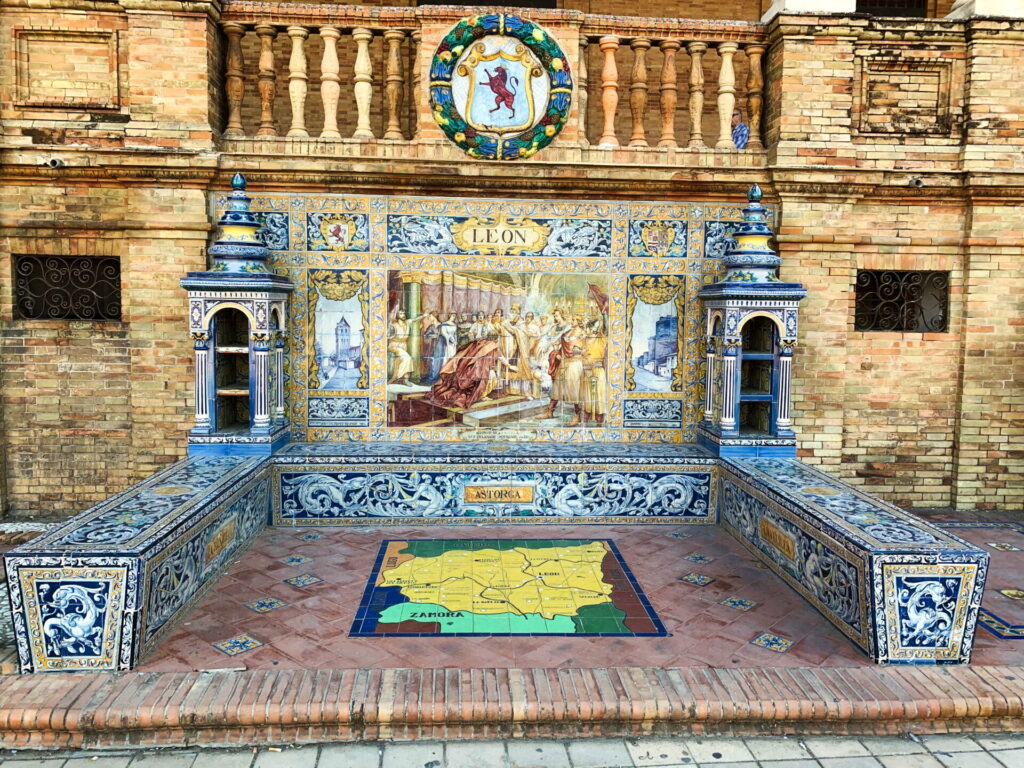
The Plaza de España was constructed for the 1929 international fair. As you walk along the Plaza, look at the tiles. Each Spanish province is represented here and each has tiles depicting historic events related to that province. While you can use this as a history lesson, one of the best things you can do here is take in the architecture and people watch. The Plaza de España was my second favorite spot for people watching (second to the steps of the Seville Cathedral).
More Things to Do in Seville, Spain
I used my two days in Seville as a chance to slow down, but if you’re full of energy, there’s plenty of other things that you can check out.
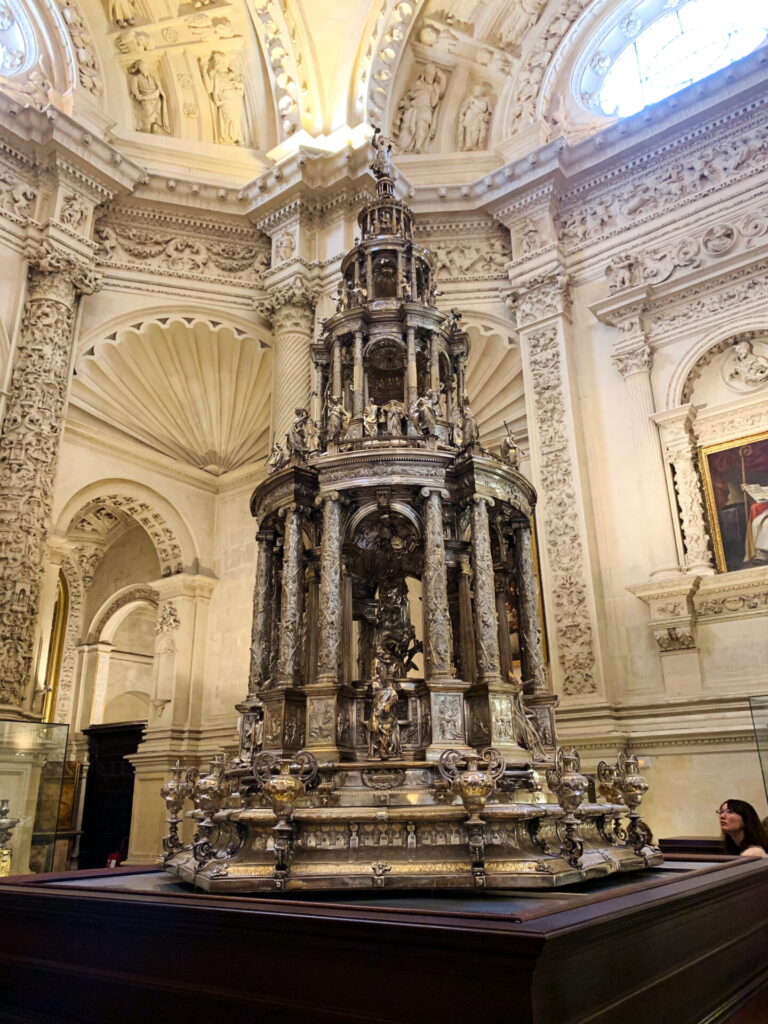
See a Flamenco Show. This is arguably one of the best cultural experiences that you can have when you’re here. For even more flamenco, you can visit the Flamenco Dance Museum (Museo del Baile Flamenco).
Visit the Museum of Fine Arts (Museo de Bellas Artes) to see works by El Greco and Goya.
If you’re not burnt out from churches, tour Basilica de la Macarena. Here you’ll see two more floats used to celebrate Semana Santa.
While controversial, Seville hosts some of the best bullfighting in Spain at Plaza de Toros. To learn about the history without witnessing the actual fight, you can tour the Bullfight Museum (Museo Taurino).

Two Days in Seville, Spain
I recommend giving yourself two days in Seville, although you could see many of the major sites in one very jam packed day. I was here for about a day and a half and took my time. Normally, I pack my itineraries with as any sights as possible. This wasn’t the case in Seville. I saw the main sights I wanted to visit, but I really enjoyed strolling through town with no set plan. Here’s what my day and a half looked like.
Day 1
12:00 – Arrive in Seville and drop off backpack at hotel
1:00 – Lunch
2:00 – Seville Cathedral and Church of the Savior
4:30 – Back to my hotel because it was so hot and humid (Hopefully you won’t need this!)
6:00 – Evening stroll through town
Day 2
9:00 – Breakfast
10:00 – Plaza de España and wandering through town
1:00 – Lunch
2:00 – Royal Alcazar
4:00 – Another break from the heat
6:00 – Evening stroll through town
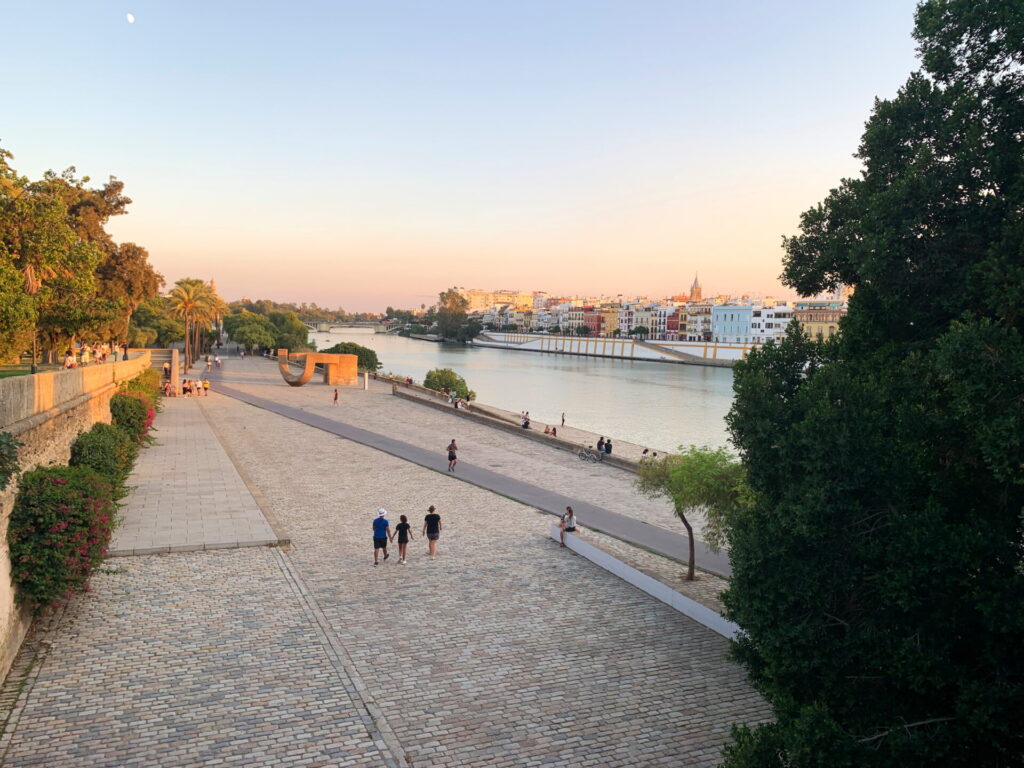
An Important Note
There’s one important note about this itinerary. I am not a night owl. Not even a little bit. This is the complete opposite of Seville and the rest of Spain. If you’re a night owl you’ll fit right in.
Between 7:00 and 8:00 pm, the city really starts to come alive and every one is out strolling and enjoying their evening. Even though I didn’t stay out very late, I still enjoyed finding a nice spot to sit where I could just watch the scene around me (the steps near the Cathedral and Plaza de España were my two favorite places to do this).

When Should You Visit Seville?
In summer, sights run a limited hours. This seems counter intuitive, but southern Spain gets unbearably hot, so locals escape the heat during the summer months by leaving the city. I visited in early October and it was still uncomfortably hot in the afternoons. Later fall will have cooler weather. Spring can be a good time to visit too, but if you’re here during Semana Santa (the week leading up to Easter), expect prices to soar, but you’ll get the incredible experience of participating in Semana Santa.
Connections to Seville
There are numerous ways to get in and out of the city. I arrived via bus from Granada and departed via high speed train to go toward Madrid. Seville also has an airport for those making longer trips.
Bus to Granada: 3 hours
High Speed Train to Madrid: 3 hours
Flight to Madrid: 1 hour and 10 minutes

Getting Around Seville, Spain
Public transportation does exist in Seville, but I walked during my entire trip to Seville and never used any busses. While it’s definitely possible to walk most places you want to visit, you may find yourself walking a lot. In fact, Seville is where I logged the most steps out of any city in Spain. If you need them, busses and trams exist to help get you around the city.
Final Thoughts
While I prefer Granada to Seville, I did enjoy my two days in Seville. The city has a more relaxed vibe than some of the other major cities in Spain which makes Seville a nice place to slow down. So, in my opinion, it’s totally worth adding two days in Seville to your itinerary. See some awesome sights, but at a more relaxed sightseeing pace.
Continue Your Adventure
Spain: Learn more about traveling in Spain in my Spain Travel Guide.
Itineraries: Seville is a popular city that makes its way onto many Spain itineraries. My Best of Spain in 10 Days itinerary is no exception.
More in Spain: Seville is lovely, but don’t forget to check out some other amazing cities during your visit. Granada is home to the Alhambra and Barcelona offers some of the most unique architecture anywhere, including the famous La Sagrada Familia. While I’m not the biggest fan of Madrid, it does has some awesome day trips in Toledo and Segovia.
